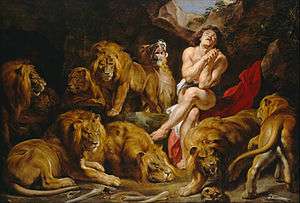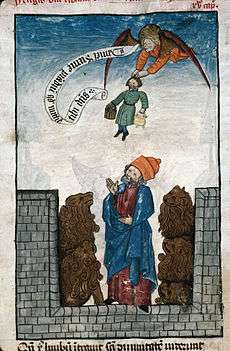Daniel in the lions' den
Daniel in the lions' den (chapter 6 of the Book of Daniel) tells of how the legendary Daniel is saved from lions by the God of Israel "because I was found blameless before him" (Daniel 6:22).[2] It parallels and complements chapter 3, the story of Shadrach, Meshach, and Abednego: each begins with the jealousy of non-Jews towards successful Jews and an imperial edict requiring them to compromise their religion, and concludes with divine deliverance and a king who confesses the greatness of the God of the Jews and issues an edict of royal protection.[3] The tales making up chapters 1–6 of Daniel are no earlier than the Hellenistic period (3rd to 2nd century BC)[4] and were probably originally independent, but were collected in the mid-2nd century BC and expanded shortly afterwards with the visions of the later chapters to produce the modern book.[5]
Daniel's age


Summary
Daniel is raised to high office by his royal master Darius the Mede. Daniel's jealous rivals trick Darius into issuing a decree that for thirty days no prayers should be addressed to any god or man but Darius himself; any who break this are to be thrown to the lions. Daniel continues to pray to the God of Israel, and the king, although deeply distressed, must condemn Daniel to death, for the edicts of the Medes and Persians cannot be altered. Hoping for Daniel's deliverance, he has him cast into the pit. At daybreak the king hurries to the place and cries out anxiously, asking if God had saved his friend. Daniel replies that his God had sent an angel to close the jaws of the lions, "because I was found blameless before him." The king commands that those who had conspired against Daniel should be thrown to the lions in his place with their wives and children, and that the whole world should tremble and fear before the God of Daniel.[6]
Composition and structure
It is generally accepted that the Book of Daniel originated as a collection of folktales among the Babylonian diaspora, the Jewish community living in Babylon and Mesopotamia, in the Persian and Hellenistic periods (5th to 2nd centuries BC).[7] Chapters 4–6, which includes the tale of Daniel in the lions' den, may belong to the earliest stage, as these differ quite markedly in the oldest texts.[8] Although the entire book is traditionally ascribed to Daniel the seer, the tales of chapters 1–6, including the story of the lion's den, are the voice of an anonymous narrator (except for chapter 4 which is in the form of a letter from king Nebuchadnezzar).[9] It is possible that the name of Daniel was chosen for the hero because of his reputation as a wise seer in Hebrew tradition.[10]
Chapters 2–7 are in Aramaic, and are in the clear form of a chiasm (a poetic structure in which the main point or message of a passage is placed in the centre and framed by further repetitions on either side):[11]
- A. (2:4b-49) – A dream of four kingdoms replaced by a fifth
- B. (3:1–30) – Daniel's three friends in the fiery furnace
- C. (4:1–37) – Daniel interprets a dream for Nebuchadnezzar
- C'. (5:1–31) – Daniel interprets the handwriting on the wall for Belshazzar
- B'. (6:1–28) – Daniel in the lions' den
- B. (3:1–30) – Daniel's three friends in the fiery furnace
- A'. (7:1–28) – A vision of four world kingdoms replaced by a fifth
The story of Daniel in the lions' den in chapter 6 is paired with the story of Shadrach, Meshach, and Abednego and the "fiery furnace" in Daniel 3. The parallels include the jealousy of non-Jews, an imperial edict requiring Jews to compromise their religion on pain of death, and divine deliverance. Each story climaxes with the king confessing the greatness of the God of the Jews and issuing an edict of royal protection. In each case life is preserved through divine presence in the fire or the pit.[3]
The structure of Daniel 6 itself is also in the form of a chiasm:[12]
- A. Introduction: Daniel’s success (vv.1–3)
- B. Darius’s edict and Daniel’s response (vv.4–10)
- C. Daniel’s opponents plot his death (vv.11–15)
- D. Darius hopes for Daniel’s deliverance (vv.16–18)
- D'. Darius witnesses Daniel’s deliverance (vv.19–23)
- C'. Daniel’s opponents sentenced to death (v.24)
- C. Daniel’s opponents plot his death (vv.11–15)
- B'. Darius’s edict and doxology (v.25–27)
- B. Darius’s edict and Daniel’s response (vv.4–10)
- A'. Conclusion: Daniel’s success (v.28)
Rabbinic literature

According to Josippon, "the beasts in the den received Daniel as faithful dogs might receive their returning master, wagging their tails and licking him." The Midrash Tehillim says that "the mouth of the den was closed with a huge stone, which had rolled of itself from Palestine to Babylon for that purpose" and that "upon this stone sat an angel in the shape of a lion, so that Daniel's enemies might not harass him."[13]
Artistic representations
In visual arts
Although Daniel is sometimes depicted as a young man in illustrations of the incident, James Montgomery Boice points out that he would have been over eighty years old at the time.[1]
Painters who have depicted this incident include:
- Jan Brueghel the Younger, Daniel in the Lions' Den
- Briton Rivière, Daniel's Answer to the King
- Peter Paul Rubens, Daniel in the Lions' Den
- Henry Ossawa Tanner, Daniel in the Lions' Den
- David Teniers the Younger, Daniel in the Lions' Den
In music
- In February 1927, the Norfolk Jubilee Quartette recorded "Daniel in the Lions' Den" on the Paramount label. The song bears close melodic and lyrical resemblance to "Now is the Needed Time," recorded (without reference to Daniel and the lions) in the 1950s by Sam Lightnin' Hopkins
- The 1929 gospel blues song "I've Got the Key to the Kingdom" by Washington Phillips retells the story
- On February 10, 1959, in Cincinnati, he Stanley Brothers recorded "Daniel Prayed", a bluegrass retelling of the story. Originally issued on King LP 645, the song has also been recorded by many bluegrass country and gospel artists and groups such as Doc Watson, Boone Creek, The Isaacs, Ricky Skaggs. The Cathedrals and The Gospel Plow Boys.
- The 1964 Broadway Musical Fiddler on the Roof by Jerry Bock and Sheldon Harnick includes a song called "Miracle of Miracles", in which Motel, the tailor, sings "Wonder of wonders; miracle of miracles; God took a Daniel once again, turned him around and, miracle of miracles, walked him through the lion's den."
- In 1966, the trio of Frederick McQueen, George McKenzie, and Shelton Swain released their own original song about the story, called "God Locked the Lion's Jaw," on the album The Real Bahamas (In Music And Song)
- Lyrics on the title track of Bob Marley & the Wailers' 1979 album Survivor reference Daniel leaving the lion's den.
- The front sleeve of the 1981 album by The Sound (band) From the Lions Mouth is the painting “Daniel in the Lion’s Den” by Briton Riviere
- The 1982 song "Daniel" by Raffi on his Rise and Shine album
- The 1982 song "Lion's Den" by Bruce Springsteen, first released on the 1998 album Tracks, alludes to the story
- Patty Loveless recorded the song "Daniel Prayed" featuring Ricky Skaggs for her 2001 album Mountain Soul album.
- The 2011 song "Us Against The World" by Coldplay includes the line 'My drunken hazard Daniel in a lion's den', as a reference to being in a bad place.
- The 2013 album Bad Blood by Bastille includes a track called "Daniel in the Den"
- The 2016 album Arts & Leisure by Walter Martin (formerly of The Walkmen) includes a track called "Daniel in the Lion's Den"[14]
- Prog Metal band Dream Theater recorded the track Paralysed on their 2019 album Distance Over Time which includes the line 'The victim, the martyr... like Daniel in the Lion's Den, time and time again'.
- The 2017 album Fear Not Fantasy by Joe Ransom (an unknown songwriter of Australia, residing in Honduras) will include a track called "Science Teacher" which begins with a reference to Daniel in the Lions' Den
- Paul White's 'Accelerator' EP features a track called Lion's Den. In the chorus featuring rapper Danny Brown references "Daniel in the lion's den".
See also
| Wikimedia Commons has media related to Daniel in the lions' den. |
References
Citations
- Boice 2006, p. 68.
- Seow 2003, p. 3,85–86.
- Seow 2003, p. 86-88.
- Collins 1984, p. 28.
- Seow 2003, p. 7-8.
- Seow 2003, p. 85-86.
- Collins 1984, p. 29,34–35.
- Redditt 2008, p. 176-177.
- Wesselius 2002, p. 295.
- Redditt 2008, p. 180.
- Redditt 2008, p. 177.
- Goldingay 1989, p. 124.
- Daniel, Jewish Encyclopedia (1906).
- "Us Against the World – Coldplay". Retrieved 2018-01-07.
Bibliography
- Boice, James Montgomery (2006). Daniel: An Expositional Commentary. Baker Books. ISBN 9780801066412.CS1 maint: ref=harv (link)
- Collins, John J. (1984). Daniel: With an Introduction to Apocalyptic Literature. Eerdmans. ISBN 9780802800206.CS1 maint: ref=harv (link)
- Collins, John J. (2002). "Current Issues in the Study of Daniel". In Collins, John J.; Flint, Peter W.; VanEpps, Cameron (eds.). The Book of Daniel: Composition and Reception. BRILL. ISBN 9004116753.CS1 maint: ref=harv (link)
- Goldingay, John E. (1989). Daniel. Word Books.CS1 maint: ref=harv (link)
- Redditt, Paul L. (2008). Introduction to the Prophets. Eerdmans. ISBN 9780802828965.CS1 maint: ref=harv (link)
- Seow, C.L. (2003). Daniel. Westminster John Knox Press. ISBN 9780664256753.CS1 maint: ref=harv (link)
- Wesselius, Jan-Wim (2002). "The Writing of Daniel". In Collins, John J.; Flint, Peter W.; VanEpps, Cameron (eds.). The Book of Daniel: Composition and Reception. BRILL. ISBN 0391041282.CS1 maint: ref=harv (link)
